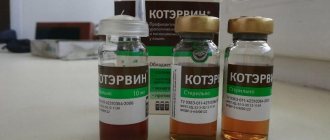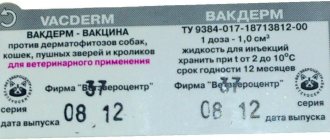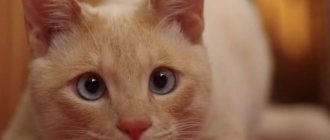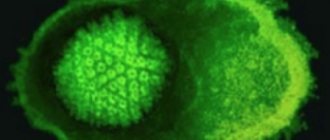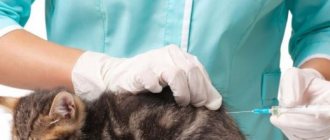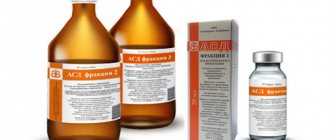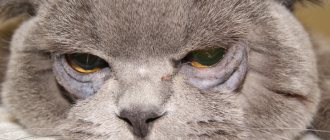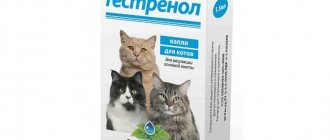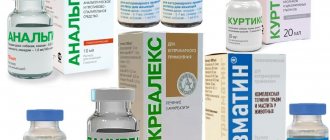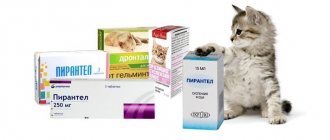Instructions for use
For prophylactic purposes, as well as to prevent relapses of diseases, the veterinary drug is administered orally, based on the calculation of 2-4 ml per adult animal once a day, for one week. The standard therapeutic course can be repeated quarterly. At the initial stage of the disease, the veterinary drug is given to the pet 2-4 ml twice a day. The administration of the drug must necessarily be supplemented by the use of symptomatic treatments prescribed by a veterinarian.
In the treatment of diseases accompanied by the appearance of blood or its traces in the urine, as well as high specific gravity and increased urine pH, the veterinary drug is prescribed at a rate of 2-4 ml twice a day. The absence of spontaneous urination requires additional administration of the drug into the bladder through a puncture or using a catheter. The simultaneous administration of intramuscular injections of the drug "Neoferon" allows you to relax the urinary tract, eliminate the inflammatory syndrome and get rid of possible concomitant infectious lesions.
The veterinary medicinal product "KotErvin" does not contain preservatives, so its use requires compliance with basic recommendations. During administration into the bladder, in order to prevent contamination, the required amount of the drug is taken from the bottle strictly using a syringe with a sterile needle. When prescribing oral administration, it is necessary to uncork the bottle, then tightly place a special dropper cap on its neck and introduce the product into the animal’s oral cavity by pressing the pipette three times.
The drug remaining after use should be stored in the refrigerator for no more than seven days, without removing the dropper cap from the bottle, and immediately before the procedure, the product must be heated to body temperature and shaken vigorously several times.
Tactics for using uroseptics in general practice
To this day, uroseptics remain the main means of pathogenetic therapy for urinary tract infections. The most important way to increase the effectiveness of treatment is not only the creation and implementation of new uroantiseptics, but also improving the tactics of using existing agents. Drugs that are classified as uroseptics are summarized in Table. 1.
Table 1. Pharmacological drugs related to uroseptics
— oxolinic acid (gramurin) — cinoxacin (cynobac) — nitroxoline (5-NOK) — nalidixic acid (nevigramon, negram) — pipemidic acid (palin, pimidel, pipem) — nitrofural (furacilin) — nitrofurantoin (furadonin, nitrofurantoin) — nifuratel (macmiror) - nifurtoinol - furazidin (furagin) - furazolidone (furazolidone) - methenamine (uroflux) - trimethoprim (trimopan, triprim) |
The problem of optimal choice of uroseptic in the treatment of a particular patient dictates the need to answer many questions. First of all, it is necessary to find out the localization of the urinary tract infection, determine the type of pathogen and its sensitivity to the selected uroseptic, the severity of the inflammatory process, and the functional state of the kidneys. In addition, it is necessary to have a clear understanding of the pharmacokinetics and pharmacodynamics of the drug.
Only after answering these questions does the choice of drug become truly optimal.
Speaking about the localization of infection, we must not forget that even the same patient may have different microflora in the kidney parenchyma and in the urinary tract.
As a rule, in the early stages of the disease, a monoinfection is detected; with a longer course of the process, in the case of inadequate antibacterial therapy, microbial associations appear, including up to two or three types of pathogens, often both gram-negative and gram-positive.
The most common pathogens are Escherichia coli and enterococci (i.e., obligate intestinal flora), as well as the hemolytic variant of Escherichia coli, Proteus, Pseudomonas aeruginosa, Staphylococcus aureus, and Klebsiella. Moreover, associations of various types of pathogens with pyelonephritis occur in 20-45.5% of cases. In approximately 15% of cases of chronic pyelonephritis, it is not possible to identify the pathogen in the usual way, either in urine cultures or in cultures of renal tissue. Pathogens that have transformed into forms lacking cell walls (L-forms) and mycoplasmas require complex diagnostic media and techniques for their detection.
Identification of the pathogen allows you to select the most effective uroseptic. Currently, there are clear recommendations on the choice of uroseptic depending on the pathogen, and there is a lot of information on this issue in the literature. In situations where urine culture and flora sensitivity results cannot be expected, standardized antibacterial regimens may be used. For example, it is possible to use gentamicin, if necessary in combination with cephalosporins, or a combination of carbenicillin (pyopene) with nalidixic acid, colymycin with nalidixic acid.
Currently, in severe forms of urological infection - pyelonephritis, urosepsis, in case of resistance to other classes of antimicrobial substances, in the presence of multiresistant strains of bacteria - it is recommended to use fluoroquinolone antibiotics.
If it is necessary to carry out therapy with uroseptics for a long time, with changing drugs every 7-10 days, it is advisable to consistently use drugs that act on the bacterial wall and on the metabolism of the bacterial cell. Sequential use of penicillin and erythromycin, cephalosporins and chloramphenicol, cephalosporins and nitrofurans is recommended to prevent the survival of protoplast and L-form bacteria.
All of the listed groups of uroseptics penetrate well into the tissues of the genitourinary system and urine, where concentrations sufficient to obtain a therapeutic effect are created. At the same time, checking the excretory function of the kidneys is mandatory in each case. With pronounced sclerotic changes and damage to the glomerular apparatus of the kidneys, the success of treatment decreases, and when glomerular filtration decreases to 30 ml/min, there is no point in carrying out antibacterial therapy, since it is impossible to obtain a therapeutic therapeutic concentration of drugs in the renal parenchyma. In addition, the risk of developing toxic effects increases sharply. A decrease in the functional capacity of the kidneys forces us to pay special attention to the nephrotoxicity of the drugs used.
Fluoroquinolones, oxacillin, methicillin, carbenicillin from the penicillin group, macrolides, cephalosporins, and chloramphenicol have virtually no nephrotoxic effects.
Ampicillin, lincomycin, nitrofurans, nalidixic acid, and some long-acting sulfonamides have slight nephrotoxicity. In the presence of renal failure, tetracyclines become nephrotoxic. Aminoglycosides (gentamicin, streptomycin, torbamycin, kanamycin) are always highly nephrotoxic.
The nephrotoxic effects of the drugs are enhanced by severe dehydration and while taking diuretics.
One of the most important criteria for choosing a drug is urine pH. Aminoglycosides and macrolides exhibit maximum effectiveness in an alkaline environment at pH = 7.5–9.0; as urine pH decreases, their activity decreases. The effectiveness of cephalosporins, fluoroquinolones, glycoproteins, tetracyclines, and chloramphenicol does not depend on urine pH. In an acidic environment at pH ≤ 5.5, penicillins, derivatives of naphthyridine, nitrofuran, quinolone, 8-hydroxyquinolone, and metepamine are most effective. All these drugs significantly reduce their activity as the environment becomes alkalized.
In order to increase the alkalinity of urine, it is possible to prescribe a dairy-vegetable diet and sodium bicarbonate. To reduce the pH of urine (acidify it), increase the consumption of bread and flour products, meat and eggs. Ammonium chloride, ascorbic acid, methionine, hippuric acid (which is found, for example, in cranberry juice) are prescribed. Any substance that reduces urine pH below 5.5 inhibits the development of bacteria in the urine.
In the presence of microbial associations, it is possible to use a combination of two uroseptics.
Fluoroquinolones have good compatibility with most antimicrobial drugs and the absence of adverse reactions during combined antibacterial therapy.
β-lactams (penicillins, cephalosporins), aminoglycosides and polypeptides have a synergistic effect and can be combined in severe forms of infection. Moreover, all of the listed groups of antibiotics exhibit antagonism when interacting with tetracyclines, macrolides, and lincomycin.
Levomycetin, tetracyclines and macrolides show indifference when prescribed together. Nitrofurantoin weakens the effect of nalidixic acid. It is considered inappropriate to prescribe the following combinations: furagin with chloramphenicol, furagin with sulfonamides, chloramphenicol with sulfonamides, methenamine with sulfonamides.
Both the choice of drug combination and the required duration of course therapy and the route of drug administration depend on the location of the infection, the severity of the process, and the pathogen.
Doses of drugs for course therapy are given in table. 2. When carrying out treatment, it should be remembered that resistance of microorganisms develops to some drugs. This should be especially taken into account if intermittent therapy is necessary. Preference should be given to drugs to which resistance develops relatively slowly: these are fluoroquinolones, ampicillin, chloramphenicol, depot sulfonamides. Resistance to furagin develops especially slowly, so this drug is the most important when carrying out long-term intermittent treatment.
Resistance of microorganisms to nalidixic acid, oxolinic acid, tetracyclines, streptomycin, and cephalosporins develops quite quickly and often.
Given the above, you should always find out which drugs were used in previous therapy and evaluate the degree of their effectiveness.
It is also necessary to clarify the side effects that occurred during previous therapy and take into account the possibility of their occurrence during the treatment.
All of the above indicates that even with a mass of recommendatory literature with a large number of different treatment regimens, the approach to the treatment of urinary tract infections cannot be mechanical and requires an individual choice of treatment tactics for each specific patient.
Literature
- Padeiskaya E. N. The importance of fluoroquinolones in the treatment of urinary tract infections // Breast Cancer. No. 10. P. 477-478.
- Bertrand G., Katzung. Basic and clinical pharmacology. T. 2.
- Barkhanova A. G., Zakharova G. Yu. Use of antibacterial drugs in chronic pyelonephritis. Tutorial. Moscow, 1977. P. 23.
- Nephrology in 2 vols. edited by I. E. Tareeva.
Questions that a general practitioner should answer when choosing a uroseptic
- At what pH of the environment is the uroseptic effect optimally realized?
- What is the possibility of the combined use of uroseptics, their interactions, synergism or antagonism of action?
- What is the required duration of course therapy to obtain the best effect?
- How quickly does drug resistance develop?
- What is the most appropriate route of administration of the drug?
- What is the optimal dose needed to treat a particular patient?
- What is the nephrotoxicity of uroseptic?
- What are the possible side effects?
Composition and release form
The drug "CotErvin" is an aqueous remedy extracted from highly effective medicinal plants. The product is in the form of a yellowish-brown liquid and has a light and rather pleasant, specific herbal odor. The composition of this drug is presented:
- steelweed root - a component containing tannins and a whole range of organic acids that normalize the tone of smooth muscles, increase diuresis, and also have a fairly pronounced analgesic effect;
- knotweed and knotweed, which have approximately the same properties, which is due to the tannins, vitamins, flavonoids, and silicic acid they contain. Such components have an anti-inflammatory and diuretic effect, strengthen capillary walls well, and also ensure the removal of stones from the body;
- horsetail, rich in flavonoids, containing water-soluble forms of silicic acid and triterpene saponites. This component of the veterinary drug has a pronounced anti-inflammatory effect, promotes the passage of urine, and is also characterized by a hemostatic effect.
Top Articles : Earth Day: History, Impact, and How You Can Help Protect Wildlife
The standard composition of the drug includes 1.5% steelweed root, 0.5% horsetail, 0.5% knotweed and 1.5% knotweed herb, as well as 96% distilled water. During storage of a veterinary product, a characteristic and completely natural sediment may form at the bottom of the bottle. The medicine is sold packaged in 10 ml glass bottles, packed in three bottles, equipped with a convenient dropper cap, in standard cardboard boxes.
Kotervin's analogues
If for some reason the described solution is not suitable, an analogue is selected that can replace Kotervin. The medications most similar in purpose include:
- Urolex. Drops based on medicinal plants have a complex of therapeutic effects. The drug copes with foci of inflammation, suppresses pathogenic microflora, and promotes active urination. Urolex dissolves stones well and is effective for urolithiasis. Intended for oral use, the dosage is prescribed in the instructions. Urolex is safe and is approved for cats at all stages of pregnancy and kittens weighing more than a kilogram. The only limitation is an allergy to the components of the medication. The maximum therapeutic course is one month. The cost of packaging is 150-200 rubles.
- Stop cystitis. Intended for the treatment of urological pathologies in cats, including urolithiasis. Produced in the form of suspension and tablets. The suspension has a herbal composition and is effective in the initial stages of the disease. The pills are supplemented with the active substances nitroxoline and drotaverine and are prescribed in more severe cases. It is not permissible to use Stop Cystitis in case of heart and liver failure. The course of taking the suspension is 10-14 days, tablets - one week. Approximate price 300 rubles.
- Healthy kidneys. Natural tablets consisting of 30 herbal components. They help with nephritis, the formation of oxalate and phosphoric acid stones, and foci of inflammation in the urethra. It is prohibited if the cat suffers from acute kidney failure or an allergy to the components of the medication. The duration of treatment depends on the specific pathology and lasts 2-4 weeks. The Healthy Kidneys tablets cost 120-150 rubles.
Best articles: Climatic zones of the world - classification, map and description of climate types according to Alisov
pharmachologic effect
KotErvin copes with inflammation, has stone-dissolving, diuretic properties, bacteria, and also removes salts. The herbal solution will not adversely affect the cat's body, but will improve overall health.
After active action, the drug KotErvin leaves the body in the urine. Over the years of use, animal owners have appreciated the drug, which has received many positive reviews. But, despite this, you must remember that you should always carefully study the instructions, as well as the composition. If you notice that the medicine KotErvin includes a component to which the cat was previously allergic, then under no circumstances should you use it.
Healing herbs from KotErvin can have a positive effect on the cat’s body. Thanks to the drug you can achieve many positive effects :
- cure the genitourinary system;
- dissolve accumulations of stones;
- normalize the “mechanism” of natural removal of harmful substances.
- normalize the cat’s water-salt metabolism;
- If you use the drug strictly according to the instructions, you can eliminate severe inflammation and also restore the urinary system.
© shutterstock
The liquid also contains minerals and amino acids that are very useful for cats. With their help, the animal will recover faster and its immunity will improve.
Kotervin instructions for use
Before giving Kotervin to a cat, you need to select the correct dosage prescribed in the instructions. Treatment also depends on the diagnosis made by the veterinarian.
Schemes for using Kotervin:
- Urological syndrome. Prescribe 2 to 4 ml of solution at a time. Frequency of administration twice a day for 5-8 days. If the pathology is severe and no improvement is observed, the doctor may increase the amount of medication.
- Urolithiasis disease. Practiced in complex treatment, the dosage is 3-4 ml, it must be given to the cat twice a day.
- Prevention of urolithiasis. Kotervin is taken daily, 2-4 ml for 5 days. The course is repeated every three months.
If Kotervin has been prescribed, the doctor decides how to take it, focusing on the cat’s condition. According to the instructions, the medicine is used in two ways:
- Orally. The bottle is opened and a dispenser is placed on top. The contents are dripped directly into the cat's mouth by pressing three times. It is acceptable to give the required volume from a spoon. It is allowed to mix the solution with a small amount of water or milk.
- Into the bladder. The liquid is carefully poured into the empty bladder using a catheter. To do this, take 10-15 ml of solution with a sterile syringe and needle and gradually pour it into the catheter. The procedure is carried out twice a day until relief occurs. To reduce discomfort, the administered fluid should be warm. This method is prescribed for severe disease and advanced inflammatory processes.
KotErwin for cats - reviews
Owners of felines quite often use a drug with a natural composition and leave reviews about it, trying to reflect all the advantages and disadvantages of the herbal infusion.
Angelina
I know from my own experience how difficult it is to treat urolithiasis in cats. That is why I started giving my second pet drops of KotErwin from the age of 9 months for preventive purposes. The veterinarian advised, in addition to herbal medicine, to adjust the diet to avoid obesity, control the drinking regime and under no circumstances give the fluffy fish any fish. I really like KotErvin, because my cat drinks it with pleasure, and the price is quite affordable.
Elena
My cat is already 16 years old. For 8-9 years I have been giving KotErwin several times a year for prevention. One package contains several bottles, a cap (easy to put on, but difficult to remove) and a bottle opener. My purr feeds on economy food and periodically walks outside in any weather. There were no problems with the genitourinary system. The drug was well tolerated and did not cause us any side effects.
Alexander
My pet recently became ill with urolithiasis. How much pain and torment they experienced. After the examination, the veterinarian placed a catheter and prescribed infusions into the bladder of KotErwin. He told me how to give the drops. I also periodically poured in water using a syringe, since the fluffy stopped drinking on its own. With the help of a herbal preparation I was able to get rid of the catheter quite quickly. Gradually, the pet's health returned to normal. Now I will give drops to my pet every 3 months for preventive purposes.
Precautionary measures
The herbal veterinary product supplied by a well-established domestic veterinary product does not fall into the category of dangerous drugs. At the same time, manipulations with the drug "CotErvin" require obligatory adherence to the general rules of personal hygiene and standard safety precautions that are provided for when working with such veterinary drugs.
Due to the absence of toxic components and preservatives in the composition, even pet owners with a history of allergic reactions to chemicals or dyes can work with KotErvin.
Side effects
Despite the small number of contraindications, there are other dangers for the animal. In particular, some cats may experience the effect of intoxication - this is a common reaction to the drug, if this occurs, it is necessary to monitor the water regime.
Individual intolerance to any component of the drug may cause an allergic reaction. Sensitivity can be manifested by loss of appetite, lethargic behavior, and severe scratching of the skin. If symptoms appear, you should consult a doctor so that he can select a similar drug.
One of the dangerous side effects can be renal colic, which is caused by a decrease in stones and an increase in their mobility. The active ingredients in the product affect the size of stones to facilitate urination, but can also cause pain in the animal. If any symptoms of poor health are detected, you must stop taking the drug and relieve pain, and then consult a doctor.
Reference! During the studies, no cases of drug overdose were identified.
Description of the drug Kotervin
Kotervin for cats and kittens is a solution for internal use. The liquid is light or dark brown in color, with some sediment allowed. Available in 10 ml or 16 ml volumes. The package contains 2 or 3 transparent vials, a dispenser and instructions for use.
Best articles: Fishing cat, or civet cat
The effect of taking Kotervin is achieved through a combination of herbal components. The composition includes infusions of medicinal herbs:
- Knotweed herb. Enriched with vitamins and tannins. Promotes the removal of urine, the advancement of stones, strengthens blood vessels.
- Horsetail. Stops inflammatory processes and has hemostatic properties.
- Field steelroot. Rich in silicic acid and flavonoids. Has a beneficial effect on muscles: relaxes, suppresses pain, relieves spasms.
- Highlander. Dissolves stones, suppresses inflammation, stimulates kidney function.
The combination of herbal infusions in Kotervin has the following therapeutic effects:
- stimulates urine output;
- relieves foci of inflammation;
- resolves stones;
- removes salt deposits;
- relieves spasms;
- eliminates pain;
- prevents the development of further relapses of urolithiasis.
Since the medication contains no preservatives, the solution must be kept in the refrigerator. An opened bottle can be stored for one week.
CatErwin or Stop-cystitis: what to choose
The market for medications for cats is now so diverse that many pet owners are simply lost. Thus, several drugs can be called analogues of KotErwin:
- Stop cystitis, suspension or tablets.
- Cat Baiyun. A completely herbal preparation for cats, which, as a rule, is used to correct the animal’s behavior and with excessive excitability and sexual hunting.
- Divopride. Copes with inflammatory processes in the genitourinary area, as a rule, it is used as part of complex therapy. The main active substance is bearberry extract.
- PHYTOELITE Healthy kidneys. An effective remedy based on horsetail herb, birch leaves, chamomile flowers and other plant components, intended for the treatment of kidney diseases in cats and dogs.
Let's figure out which drug - Stop Cystitis or KotErwin - is more effective. Both components contain natural ingredients. The components of KotErwin were described above, and Stop Cystitis includes the following herbal extracts:
- knotweed herbs;
- juniper fruits;
- licorice root;
- lingonberry leaves;
- nettle leaves.
The drug is available in tablet and suspension forms, so the animal owner has a choice.
They begin to use it for the following diseases: cystitis, urethritis, pyelonephritis, urolithiasis. There are few contraindications and they coincide with the contraindications for KotErivn: an allergic reaction to the component or an honorable deficiency. Also, Stop Cystitis cannot be used in acute heart failure.
In general, animals with cystitis should be given Stop-Cystitis, the remedy will be more effective , but with urolithiasis, KotErwin will be more useful.
Purpose of the drug
The drug "CotErwin" for pets has a mild diuretic effect, has stone-dissolving and salt-removing properties. Veterinarians prescribe this drug to animals to prevent the appearance and development of inflammatory processes. The drug, completely absorbed by the pet’s body, does not have cumulative, embryotoxic or teratogenic properties, due to which it has proven itself in the treatment of urolithiasis and cystitis, as well as urological syndrome.
Having pronounced diuretic properties, as well as promoting the removal of salts and dissolution of stones, the drug "CotErvin" is characterized by a lack of effectiveness against oxalates, which must be taken into account when prescribing this drug.
special instructions
When using KotErwin, it is recommended to follow the following rules:
- The herbal infusion can only be stored in the refrigerator, since it does not contain dyes or preservatives.
- The shelf life of an open bottle is no more than 7 days.
- Before use, the bottle is opened and a special dispenser is immediately put on it. The solution is injected dropwise directly into the cat's oral cavity using three clicks on the pipette. If you can’t give your pet something to drink this way or from a spoon, the medicine can be dissolved in milk.
- When introducing the drug into the bladder, it is necessary to ensure that the syringe and catheter are sterile. Before use, the solution should be shaken well and warmed.
Contraindications
The peculiarities of the composition of the herbal product reduce the presence of contraindications to the use of the drug "CotErvin" to zero. At the same time, experienced veterinary specialists note that with the judicious use of this drug according to the instructions supplied by the manufacturer, the appearance of any side effects is not provoked.
However, in extremely rare cases, the herbal components of this drug may well cause the development of allergic reactions in an animal. According to veterinarians and the manufacturer, the most important contraindication to the use of the drug "CotErwin" is severe renal failure in a four-legged animal.
The main contraindications for prescribing the herbal veterinary drug "CotErwin" also include the presence in the pet's history of evidence of increased individual sensitivity to the components of the drug.
Indications for use
The instructions list the following indications for the use of Kotervin in the form of drops:
- urological syndrome;
- ICD;
- cystitis.
The veterinary drug is used for the prevention and complex therapy of the diseases described above.
Important! Among males, struvite is often found, which causes blockage of the urinary tract and kidney failure, and subsequently death. This disease is less common in cats because they have a wider urethra. Therefore, the cat must be given Kotervin to prevent urethral obstruction.
Taking Kotervin Phytodiet is indicated before symptoms of urinary system dysfunction appear in cats. The feed additive maintains its functionality. It is ineffective for cystitis, urolithiasis and other pathologies.
